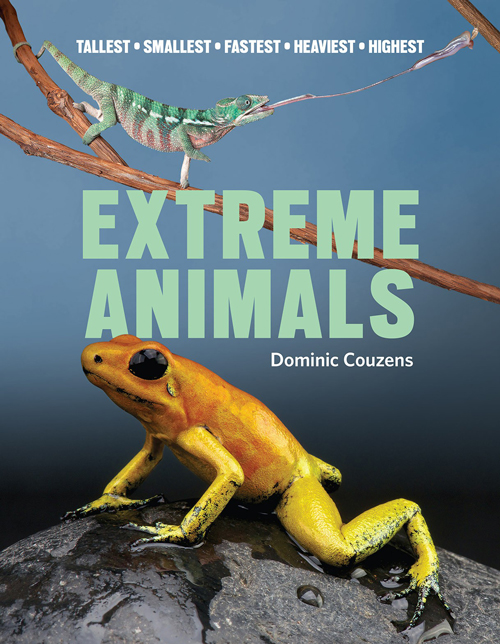Meet the world’s strangest, most remarkable animals

 You think that the world’s smallest fish is the one you caught last time you went fishing? Not even close. The smallest fish ever lives in Sumatra and makes a sardine look huge. Extreme Animals, by Dominic Couzens, is a hard cover book filled with photos and facts about the animal kingdom that are sure to fascinate.
You think that the world’s smallest fish is the one you caught last time you went fishing? Not even close. The smallest fish ever lives in Sumatra and makes a sardine look huge. Extreme Animals, by Dominic Couzens, is a hard cover book filled with photos and facts about the animal kingdom that are sure to fascinate.
Did you ever think about the trials and tribulations of the female octopus? A deep sea octopus has recently been recorded taking care of her clutch of eggs for a period of four and a half years. During this time, she was observed to tend the eggs rather than eat easily available food. She had a good news outcome, with 160 babies successfully hatched. Hopefully she doesn’t have to go through that too often!
Bee and ant colonies are illustrations of organisation at the highest level; therefore it’s not surprising to find that each insect has an allocated task. One percent of the worker insects within a colony perform an undertaker role, carrying the bodies of their dead up to 200 metres away from the nest. In the case of ants, once an individual has performed this task, it is not allowed to come in contact with the queen or larvae in case it transfers an infection back into the colony.
We do not know how the spider managed this feat, but the world’s biggest web was built across a river on the island of Madagascar. The web was constructed by Darwin’s Bark Spider, and had 32 insects caught and wrapped within the web. Researchers couldn’t figure out how the spider managed to attach the web to both sides of the river without meeting a watery end. It seems that persistence paid off and the victor got to feast on a multitude of insects.
Another spider conundrum is the Himalayan Jumping Spider who lives a lonely life in rock fissures on Mount Everest. No other insect is known to survive at these freezing temperatures to provide food for the spider, and it is thought to survive by eating frozen insects that are blasted in from below on the wind. He really does live on frozen dinners.
Vampire bats have a specialised diet – only blood must past their lips. They cannot survive for more than three days without ingesting blood. What to do if you are a starving vampire bat who has not managed to get a feed? It’s all good apparently, as members of the colony will help you out with a quick transfusion, after grooming you to ensure that you are not faking it. No bat can be sure when it will require this assistance from a colony mate; therefore they engage in this reciprocal altruism which is not common in the animal kingdom.
 Being one of a kind for forty years makes George the Pinta Island Galapagos Giant Tortoise rate as the world’s loneliest animal until the time of its recent demise. He was aged over 100, and although other Giant Tortoises exist, he was the last of his sub-species. His problems began when goats were introduced to Pinta Island, which destroyed tortoise habitat and made it difficult to find food. George lived as a pet at the research station leading up to his death. Good news is that the goats have now been eliminated, although it is too late for George and his kind.
Being one of a kind for forty years makes George the Pinta Island Galapagos Giant Tortoise rate as the world’s loneliest animal until the time of its recent demise. He was aged over 100, and although other Giant Tortoises exist, he was the last of his sub-species. His problems began when goats were introduced to Pinta Island, which destroyed tortoise habitat and made it difficult to find food. George lived as a pet at the research station leading up to his death. Good news is that the goats have now been eliminated, although it is too late for George and his kind.
This book is packed with delightful and intriguing details, and divided into chapters arranged by the group of creature. It would be of interest to nature lovers of any age, and inspires delight in our natural world.
With thanks to New Holland Publishers for my advanced reading copy.








 Proudly Australian owned and operated
Proudly Australian owned and operated